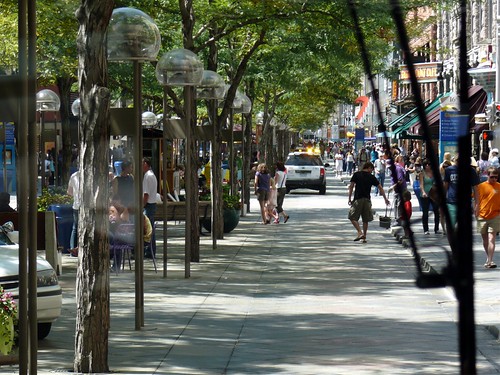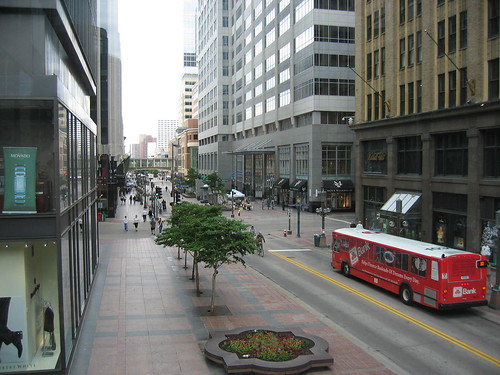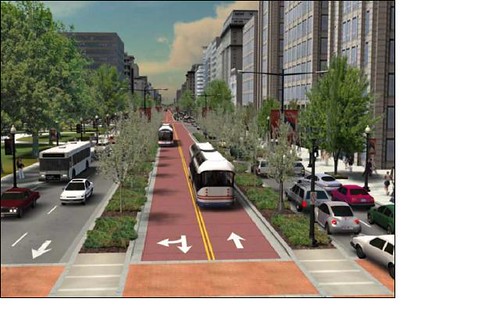Bus transit prioritization and creating a downtown transitway network
I haven't always been a fan of transit malls from an urban design standpoint, because even if they speed bus transit and make the system more legible (you know if you go to the transit mall, somehow you will find the right bus), they can be very hulking semi-desolate places.
But David Alpert in Greater Greater Washington justifiable punctures some of our bicycling hubris, pointing out in "Amid exciting innovations, DDOT neglecting bus priority," that some of the streets proposed for cycle tracks ought instead to have exclusive bus priority lanes.
It's funny now that I think about it that DC hasn't focused in the last 20 years or so on making bus transit work better and more complementary to the subway system. Sure we call attention to this. (I do in my every couple years or so "transportation wish list" which I probably will get to next month finally.) But the subway system has been prioritized to some extent at the expense of improving the quality of the bus system.
It didn't have to be that way.
Transit malls have been created in cities mostly where they don't have fixed rail transit. So they end up focusing on improving the transit they do have. The 16th Street Transit Mall in Denver and the Nicollet Mall in Minneapolis do a better job of prioritizing transit and the quality of place than did the Transit Mall in Portland (which I haven't seen since its redesign).

Flickr photo of the Denver Transit Mall by davidwilson1949, who writes: "The 16th St. Transit Mall appears to be an economically and socially thriving place, in contrast to many other similar attempts at the same concept in other cities."

Nicolett Street transit mall, Minneapolis. Note the extra wide sidewalks, which have been created by removing through lanes. During temperate months, there are many restaurant patios which activate the space. Flickr photo by EvinDC.
The great thing about a transit mall with great quality of place is that this promotes transit as well by associating it with placemaking, instead of treating transit as a transportation service of last resort.
But still, the transit mall in Portland was a great leap forward for urban revitalization. It was an essential component of their 1972 Downtown Plan which prioritized investment downtown, and emphasized transit at the expense of automobility and parking. I think its relative success led to the embrace of the leap forward to fixed rail transit--construction of Portland's light rail system began 10 years later.
-------
This blog entry "A summary of my impressions of Portland Oregon" prints the elements of the 1972 Portland plan, including these three:
1. Creating a North-South spine of high density offices served by public transit. The (bus) Transit Malls on SW 5th and 6th Avenues, completed in 1978, provides this spine and supported private office developments.
2. Creation of an East-West retail spine along Morrison Street that would lead the city back to the river. The MAX light rail line and rebuilt streets on Morrison and Yamhill implement that concept. Waterfront Park, which replaced an expressway, provides a riverfront destination.
4. Emphasis on transit and alternative modes for downtown access and limitations on parking. The plan prohibited new parking unless associated with new development and it prohibited the demolition of historic buildings for parking lots.
-----------------
The reason I don't totally love it has to do with when it was built and the urban renewal like designs of the transit shelters--very hulking--some of the buildings along the street--set back significantly from the street--and the lack of other quality placemaking aspects, unlike say in Denver or Minneapolis.
DC's current "priority" bus lanes on 7th and 9th Streets don't work very well because relatively speaking, the lanes are not used very much during the hour as only one or two bus lines use the streets. Also see this paper, "Effective Bus-Only Lanes," about bus priority lanes in San Francisco.

And maybe the bus markings on the street can be better too, to limit the number of incursions. This is an example from Australia. ("Mandatory Give Way to Buses Scheme Extended.")
What I would probably consider is making 9th Street two way and put the priority bus lanes only on 7th Street, making it a mixed traffic transitway. However, property owners would likely go apesh** if you propose eliminating street parking. On the other hand, you could widen the sidewalks a bit which is necessary there given the amount of pedestrian traffic and create a priority bus lane and then have only one other through lane in each direction. In Portland, automobiles were not supposed to use the transit mall.
But the north-south bus lines on H, I, and K Streets would use bus lanes for much of each hour. That is the point of creating the K Street Transitway, but the idea hasn't been extended to include H and I as part of a "Downtown Transitway system." (Note that I do have some issues with the K Street Transitway as it is designed to be a little too exclusive, prioritizing some bus services over others, when I think that all the public transit bus services using this corridor ought to be equally prioritized.)

K Street Transitway image. (Note the public transit bus located outside of the transitway.)
Creating an integrated Transitway System for Downtown DC, including H, I, and K Streets, along with 7th and 14th Streets, ought to be the next step in improving surface based transit downtown.
The likely reason this isn't happening, and why bicycle improvements are being prioritized has to do with how transportation planning is set up in the DC Dept. of Transportation (DDOT).
The Transportation Planning and Policy Administration, which has a strong and visionary director and a slew of committed staffers, aren't responsible for DC's transit planning. Transit planning falls under a separate bureau, the Mass Transit Administration division of DDOT.
SO you can see that since TPPA has a more robust planning capacity and leadership, that they are focusing on bicycle planning, while DC's MTA is not pushing bus priority. Yes, I recognize that the TPPA division still pushes bus priority, but you see how the bike and pedestrian unit at TPPA can be prioritized at the expense of bus, because of how active and far thinking the respective divisions are or are not when it comes to consideration of the various transportation modes under their purview.
(I happen to believe that transit planning should be merged into the Transportation Planning and Policy Adminstration unit of DDOT.)
Labels: car culture and automobility, transit, transit marketing, transportation planning



0 Comments:
Post a Comment
<< Home